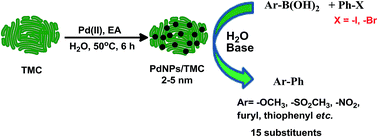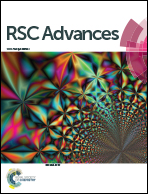Palladium nanoparticles embedded on thiourea-modified chitosan: a green and sustainable heterogeneous catalyst for the Suzuki reaction in water†
Abstract
Palladium nanoparticles (PdNPs) embedded on thiourea modified chitosan (TMC) are prepared in spherical and cubical shapes by intercalating palladium(II) acetate in TMC, a natural bio-polymer, and a subsequent reduction using ellagic acid (EA) as a natural and green reducing source in water. The formation of palladium nanoparticles in water is monitored by UV-Vis, spectroscopy and the PdNPs/TMC solid matrix are characterized by FT-IR, powder XRD and HR-TEM. The amount of palladium entrapped on TMC is measured by ICP-OES analysis, and it is found to be 0.00103 mol%. The synthesised PdNPs/TMC reported for the first time, were employed as heterogeneous catalysts for Suzuki cross-coupling reactions of aryl iodide/bromide with various substituted aryl boronic acids in water and showed high catalytic activity under mild reaction conditions. Easy separation, the absence of an inert atmosphere and good to excellent yields are the other significant outcomes of this protocol. In addition, the reactions also work well with various heterocyclic boronic acids. Also the catalyst can be easily recovered and reused for at least five runs without loss in its activity.


 Please wait while we load your content...
Please wait while we load your content...